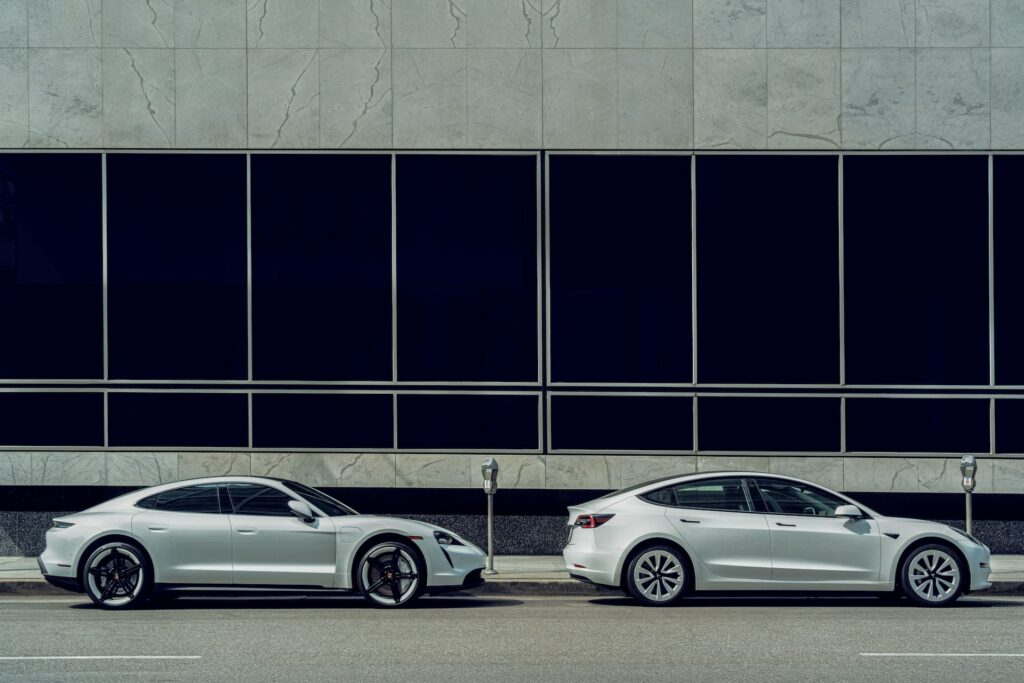Introduction – Vehicle Emissions By Car Type
A few months back I did a post called The World’s 7 Greenest Vehicles. It only included one car. Since then a few readers have emailed to ask if I could do a similar comparison, but for cars only. So here’s a very brief guide to vehicle emissions. This is for types of cars, not specific makes and models. To get a sense for specific makes and models ranges, battery sizes, it’s better to look up each EV review.

In the graph above I’ve compared the full vehicle emissions of four petrol cars (20, 30, 40 and 50 MPG) to that of an electric vehicle using four different types of electricity (coal, oil, gas and solar). In each case I include the emissions from vehicle manufacturing plus the full scope of petrol and electricity emissions. What a wonk might call well-to-wheels plus manufacturing.
We Assume “Idealized” Electricity Sources
The analysis of the four types of electricity assumes electricity derived from pure sources. This is not true of real electricity sources. In the US, every state has its own mix of sources, from natural gas to nuclear to renewables. Therefore every state will have different real world emissions for an electric car.
The results are pretty clear. The better the fuel economy of a petrol car the lower its emissions. For the electric car the major difference is the source of electricity. The lowest emissions by a distance is the electric car using solar electricity.
Electric Cars Using Renewable Energy Sourced Electricity Wins

The winner is the electric car using electricity derived from only solar. This car has emissions of 79 g CO2 / km. In the US we would convert that to 49 g CO2 / mile. Interestingly, a high efficiency petrol car (50 MPG) has emissions of 170 g CO2 / km, which beats out an electric car that uses electricity from oil and coal. The electric car using electricity from natural gas sources beats out slightly the high efficiency petrol car.
Embodied Energy – Higher For E-Vehicles And Often Ignored
Embodied energy is the energy required to produce a material or construct a product. When it comes to cars, this includes the energy used in the production of the vehicle, the fuel used to transport the car from the factory to the dealership, and the energy used to operate the factory and transport the car. Additionally, the embodied energy of a car includes the energy used to build the roads and highways that the car will be driven on.
The embodied energy of cars is an important factor to consider when discussing the environmental impact of car ownership. The more energy required to produce a car, the more emissions are released into the atmosphere and the greater the impact on the environment. Additionally, the more energy used to fuel and drive the car, the more emissions will be released into the atmosphere. This is why it is important to consider the embodied energy of a car when making decisions about what type of car to purchase.
The embodied energy of electric cars is higher than that of petrol cars due to the energy needed to extract, process, and transport the raw materials used to make the batteries. Additionally, the energy used to build and maintain the infrastructure needed to support electric cars, such as charging stations, must also be taken into account.
One way to reduce embodied energy costs is to recycle the car.
Efficient Petrol Cars Are Better Than Electric Cars Using Dirty Electricity
Therefore it’s possible that an electric car loses out to a petrol car if the source of electricity has high carbon emissions. I’ve chosen solar (45 g CO2e/kWh) as a representative renewable energy because there is high co-ownership of solar and EVs. The emissions would be just as low using hydro, nuclear, wind or any other true low carbon electricity.
That’s it, very brief as promised. Diesel is slightly better than petrol but has a particulate problem. Do you think electric cars are going to be the low carbon vehicles of the future? How about next-gen biofuels or hydrogen fuel cells? For more on vehicle emissions check our posts on electric vehicle emissions, your driving emissions and the world’s 7 greenest vehicles.
Lindsay Wilson
I founded Shrink That Footprint in November 2012, after a long period of research. For many years I have calculated, studied and worked with carbon footprints, and Shrink That Footprint is that interest come to life.
I have an Economics degree from UCL, have previously worked as an energy efficiency analyst at BNEF and continue to work as a strategy consultant at Maneas. I have consulted to numerous clients in energy and finance, as well as the World Economic Forum.
When I’m not crunching carbon footprints you’ll often find me helping my two year old son tend to the tomatoes, salad and peppers growing in our upcycled greenhouse.
